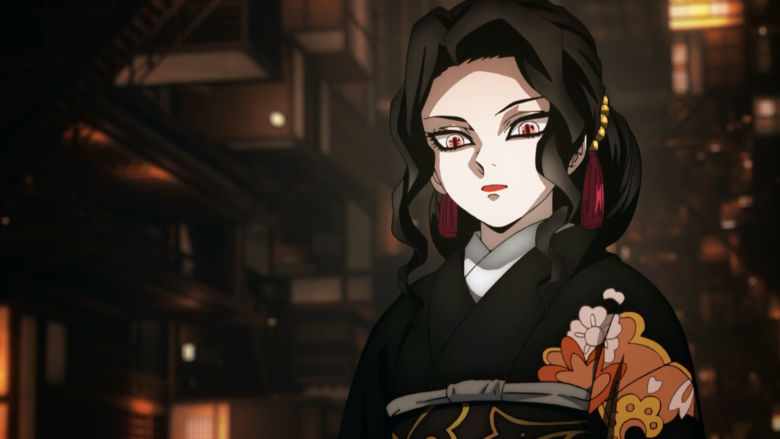みなさん、こんにちは!This article continues talking about Water Breathing forms! In the previous article, I explained both the Japanese and English names of1st Form to the 5th, as well as kanji characters used in them. If you are interested in finding out what each Water Breathing form is actually called in Japanese and how they are written using kanji, please read on while maintaining Total Concentration!
Sixth Form: Whirlpool
We will start with the sixth form:
陸ノ型 ねじれ渦
ろく の かた ねじれ うず
roku no kata nejire uzu

The user twists the upper and lower body to create a whirlpool of air that cuts the opponent. As this is the most effective in water, Tanjirō first performed this form to the Swamp Demon.
To break down these kanji in the sixth form:
渦 (uzu): Whirlpool
Additionally, ねじれます refers to ‘to twist’ and ねじれ is the noun form of this word.
Seventh Form: Drop Ripple Thrust – Curve
For the seventh form, we have:
漆ノ型 雫波紋突づき・曲
しちのかた はもんしずくづき・きょく
shichi no kata hamon shizuku zuki kyoku

This is a fast and accurate stab, and the fastest attacking form in Water Breathing. The 曲 version is a modified attack where the stabbing is performed in a curved manner. However, the original form never appeared in the series.
To break down these kanji in the seventh form:
雫 (shitata ru / shizuku): Drop / Drip
波 (ha / nami): Wave
紋 (mon): Family crest
突 (tsu ku / totsu): Stab
曲 (ma garu / kyoku): Music / Bend
Eighth Form: Waterfall Basin
In the eighth form, we have:
捌ノ型 滝壺
はち の かた たき つぼ
hachi no kata taki tsubo

This is a vertical slash which can target multiple enemies. 滝壺 is performed as the user falls downwards from a high place.
To break down these kanji in the eighth form:
滝 (taki): Waterfall
壺 (tsubo / ko): Pot
Many of the readers might be familiar with the word Taki, as this is also from the name of one of the main characters (Tachibana Taki 立花 瀧) in the film Your Name (君の名は). ‘瀧’ is a non-simplified version of ‘滝’ and they are considered the same kanji.
Ninth Form: Splashing Water Flow
We are almost coming to an end! For the ninth form, we have:
玖ノ型 水流飛沫
く の かた すい りゅう ひまつ
ku no kata sui ryū himatsu

This is a technique for a movement rather than attacking, in which the user performs fast foot work to minimise landing time and space. Moreover, there is a modified version of this form, 水流飛沫・乱 (Splashing Water Flow – Turbulent) and this only appeared once in the series when facing against 響凱 (Kyogai) and the original form never appeared.
To break down these kanji in the ninth form:
飛 (to bu / hi): Fly
沫 (awa, shibuki / matsu): bubble / splash
乱 (mida reru / ran): riot, disorder, disturb
Tenth Form: Constant Flux
Finally, this is the last form in Water Breathing:
拾ノ型 生生流転
じゅう の かた せいせい るてん
jū no kata sei sei ru ten

This is the final form in Water Breathing style. 炭治郎 (Tanjirō) performed this against 累 (Rui) and 魘夢 (Enmu). When using this form, the user performs a continuous spinning attach whose strength and power increases with each rotation. The slash takes a form of water dragon. Actually, 生生流転 is a Japanese idiomatic expression. It means everything is in flux through the endless circle of birth, death and rebirth.
To break down these kanji in the tenth form:
生 (i kiru, u mareru / sei): life
転 (koroga ru / ten): Revolve
Eleventh Form: Dead Calm
Having said that the tenth form is the final form in Water Breathing style, there is one more addition. The eleventh form is a personal creation of Giyū Tomioka, the current 水柱 (みずばしら), Water Hashira:

拾壱ノ型 凪
じゅう いち の かた なぎ
jū ichi no kata nagi
To break down these kanji in this form:
凪 (nagi): Tranquility
Summary – まとめ
To sum up, this article covered the 6th to 11th forms in Water Breathing styles. Now, you know how to call each form in Japanese, and you can write them using kanji characters! This would give you deeper understanding of the meaning of the name and effect of each form. If you have any questions, please let me know! じゃ、みなさん、さようなら!





Comments